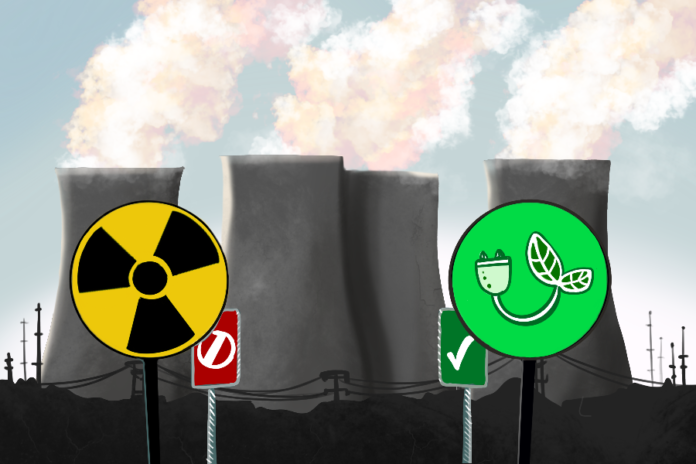Nuclear energy has potential, but stigma and lack of funding are holding it back
By MAYA KORNYEYEVA — mkornyeyeva@ucdavis.edu
Upon hearing the word nuclear, images of devastating explosions, yellow and black hazard signs and massive cylindrical power plants come to mind. Nuclear energy is rarely discussed with positive connotations in everyday conversation, which is understandable considering humanity has experienced some catastrophic disasters related to nuclear warfare and reactor meltdowns.
Most prominent among these are the two atomic bombs used against the Japanese cities of Hiroshima and Nagasaki during World War II, the meltdown of the reactor in Fukushima following the 2011 Japanese tsunami and the release of radioactive waste at the Ukrainian Chernobyl power plant in 1986. The large-scale impact of these nuclear disasters is the causal factor in the global fear of nuclear power, as power plants can be easily targeted by other countries during war and the resulting radioactive waste is extremely detrimental to the health of all living organisms.
However, if the proper time, funding and research are dedicated to pursuing safer nuclear energy development, I believe the world could benefit greatly from its utilization. For one, nuclear energy is virtually “carbon-free” — with the exception of facility construction, removal of radioactive waste and uranium extraction — meaning that it does not emit the greenhouse gas carbon dioxide into the atmosphere while generating electricity.
Furthermore, nuclear energy has a small land footprint in comparison to renewable energies like solar and wind. While a nuclear power plant can produce 1,000 megawatts of electricity per square mile, wind turbines require 75 square miles to produce the same amount, and solar, 360 square miles. Nuclear energy also has a high power output and energy density and is relatively reliable as long as it is run and maintained. In other words, while the absence or presence of the sun, wind and water alter the ability of other renewable energy sources to function consistently, nuclear only relies on the presence of uranium inside the Earth’s crust.
That being said, we cannot ignore the factor of nuclear waste. This is a major area that requires refining if we are to rely on nuclear energy as an alternative to fossil fuels in the near future. Currently, fuel that is used for five years at a power plant is designated as waste, sealed in canisters on-site, then transported to underground storage facilities without any recycling processes and left there for an indefinite amount of time. This exposes the steel and packaging material to corrosion and degradation over time, which can cause the radioactive plutonium, fission products and actinides to leak into the open environment.
As a solution to this, scientists have tested the idea of stabilizing nuclear waste via vitrification — trapping the waste particles inside solid glass. Governments have also considered shooting the nuclear waste up into space, burying it in ice, isolating it in synthetic rock, relocating it onto isolated islands or drilling it deep into the Earth. Another approach, which I think is the most promising solution, is the development of fast neutron reactors which are able to make use of the high-level waste fuel produced from current reactors.
Despite these attempts to determine the best solution for dealing with radioactive waste, no country has been successful in developing a deep repository. Looking at the progress mankind has made in the search for safe, clean energy, I have feelings of both hope and frustration.
The time to act is now; whether it is pursuing another form of renewable energy such as hydropower, wind or solar or developing infrastructure and research on nuclear power. The climate is changing and the world with it, and we must put forth the necessary time, effort and funding to mitigate the negative effects of climate change as quickly and efficiently as possible.
The goal of nuclear research should be about the future. Developing long-lasting, permanent solutions that don’t pollute the Earth is something that governments need to prioritize when creating climate policy and dedicating resources. Nuclear power has an immense amount of potential — we just need to unlock it.
Written by: Maya Kornyeyeva — mkornyeyeva@ucdavis.edu
Disclaimer: The views and opinions expressed by individual columnists belong to the columnists alone and do not necessarily indicate the views and opinions held by The California Aggie.





